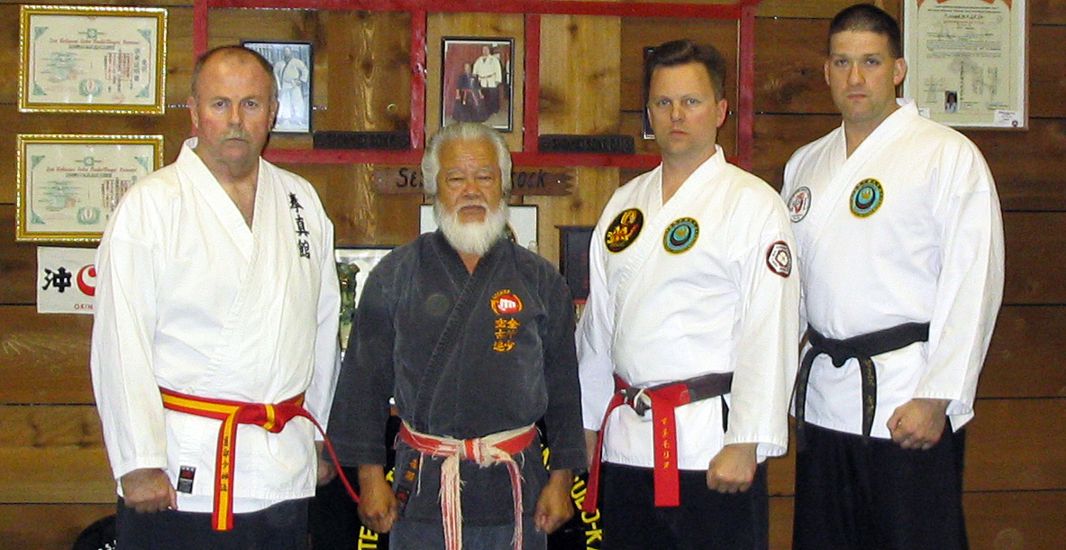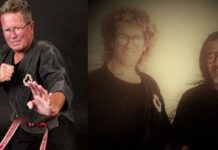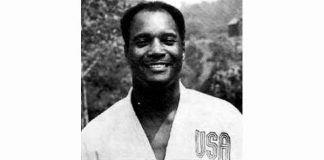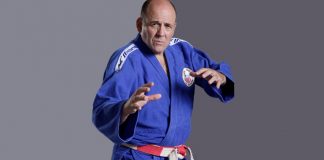8th Flying Training Squadron Commander is Fit to Fight!
Vance Air Force Base Online ~ By 2nd Lt. Lynn Aird, 71st Flying Training Wing Public Affairs / Published July 27, 2009
Above Photo Info: Lt. Col. James Gifford, far right, 8th Flying Training Squadron commander and Shimmei Shorin-ryu karate 7th degree Black Belt, poses in a dojo in Okinawa with, from left, Mr. Mike Hancock, a Shimmei Shorin-ryu karate 10th degree Black Belt, Master Fusei Kise, Shimmei Shorin-ryu karate 10th degree Black Belt and Lt. Col. Matthew Molineux, 18th Operations Group deputy commander and Shinmei Shorin-ryu karate 10th degree Black Belt.
VANCE AIR FORCE BASE, Okla. — Lt. Col. James Gifford is a multi-talented member of Team Vance. In his Air Force career he has flown KC-135s, followed by cross-training to F-15Es. At Vance he has been a T-38C Talon instructor pilot, and is currently a T-6A Texan II instructor pilot as well as commander of the 8th Flying Training Squadron.
His abilities, however, do not stop at the flight line, or even within the realm of the military. Colonel Gifford is a seventh degree black belt in Shimmei Shorin-ryu karate, and a sixth degree Black Belt in Shintoyoshin Jiu-jutsu.
“I started martial arts training when I was 8 years old in Caldwell, N.J., at the YMCA,” he explained. “The discipline of it all made sense to me; I was drawn to it.”
The style Colonel Gifford originally studied was Isshin-ryu karate. He continued to study it throughout his college years at Rutgers University. After earning his pilot wings at Reese AFB, Texas, in 1993, he went on to Castle AFB, Calif., for KC-135 co-pilot training.
“While I was at Castle, I met my current instructor, Lt. Col. Matthew Molineux,” said Colonel Gifford. “He’s a Shimmei Shorin-ryu master. I switched over to his style, and it’s been that way since 1993.”
Shorin-ryu is generally characterized by natural breathing, high, narrow stances, and direct, rather than circular movements. In Shorin-ryu, being able to move quickly to evade violence by having fluid movements and flexible positions is important. A solid structure is key for powerful moves, but stances that are too deep will most likely make body movement difficult.
According to Colonel James Gifford the transition between styles was simple, as they are closely related.
“What separates the style that I study from most of the other styles is historical correctness and applicability in combat,” said Colonel Gifford. “Other forms are used more to instill a lifestyle–to give discipline, strength, cardio; they’re very good for developing health, but aren’t very applicable in an actual fight.”
Despite his capability as a fighter, Colonel Gifford asserted that purpose of studying martial arts is to ‘fight without fighting.’ He belongs to an organization called the International Okinawan Budo Kai, where students are taught that karate is to be used as a deterrence to, and not a way of, violence.
“It sounds corny, but it’s correct,” said Colonel Gifford. “You never have to use it if you know what you’re doing. I prefer to call it the Nike black belt, ‘just run’, because it’s easier that way.”
Colonel Gifford has been actively instructing karate for over 20 years. Of particular importance in his training and that of his students are katas, pre-arranged sets of body movements. In each kata are hidden maneuvers called bunkai, which are the interpretations of the form. Bunkai explain what is going on, how one is being attacked and how one would hit an attacker, as well as different balance points and pressure points.
“Knowledge of the bunkai is what sets true masters apart from the rest,” explained the colonel. “Not only can I show you the form and reproduce it and teach it, but I can also show you why the move is the way it is and how you execute it against an opponent. It’s interesting to see how students react when you show them how any human being becomes very fragile if you apply pressure to the correct points.”
Colonel James Gifford works out three or four days a week lifting weights and running, along with practice to maintain his proficiency in Shorin-ryu.
“I still have to maintain my own abilities–I’m held responsible for the data that I have,” he said. “Whenever I see Colonel Molineux, I’m expected to perform at my level.”
Although has continued to hone his skills since coming to Vance, Colonel Gifford has not gotten to teach as much as he would like.
“The mission has to come first,” he explained. “But martial arts and the military are naturally complimentary. Both build a strong body, a strong mind, and focus. I attribute my success in school and in the military to discipline, and the discipline came from karate. I would love to teach on base if I had the time.”






